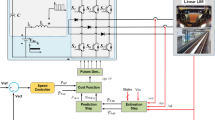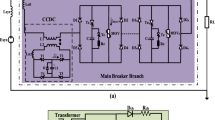Abstract
This paper elucidates a direct approach to the theory and modeling of a standard 150KW doubly fed induction machine (DFIM) model for voltage and power stability analysis. It includes all models of major system components such as the DFIM model, the grid and the bidirectional multi-level power converter models using space vector pulse width modulation technique. All network models were implemented and simulated using the αβ transformation realized in MATLAB 7.5. The simulation results obtained from the proposed research work for the power converter and grid path of the network were duly presented for clarity. A comparative analysis of the simulation results of the DFIM with and without a protective crowbar is also presented as a contribution for further analysis of the machine understudy.

Similar content being viewed by others

Abbreviations
- R c :
-
Crowbar resistance
- L c :
-
Crowbar inductance
- L s :
-
Stator inductance
- R s :
-
Stator resistance
- L r :
-
Rotor inductance
- R r :
-
Rotor resistance
- L m :
-
Magnetizing inductance
- E m :
-
Magnetizing induced emf
- E r :
-
Rotor induced emf
- R core :
-
Core resistance
- t a :
-
Switching period for the first active vector “a”
- t b :
-
Switching period for the second active vector “b”
- t o :
-
Switching period for the zero vector “o”
- t s :
-
Sampling time
- \({ \psi_{\alpha \beta }^{\rm s} }\) :
-
Stator flux linkages in αβ plane
- \({ \psi_{\alpha \beta }^{\rm r} }\) :
-
Rotor flux linkages in αβ plane
- σ :
-
Rotor leakage inductance coefficient
References
Abad G., Lopez J., Rodriguez M.A., Marroyo L., Iwanski G.: Doubly Fed Induction Machine Modeling and Control for Wind Energy Generation. Wiley, Chichester (2011)
Mora J.F.: Electrical Machines. McGraw Hill, New York (2003)
Chapman S.J.: Electrical Machines. McGraw Hill, New York (1985)
Bose B.K.: Power Electronics and AC Drives. Prentice Hall, Englewood Cliffs (1986)
Hofmann, W.; Okafor, F.: Doubly-fed full-controlled induction wind generator for optimal power utilization. In: Proceedings of the PEDS’01 (2001)
Rashid M.H.: Power Electronics Hand Book. Academic Press, New York (2001)
Mohan N., Undeland T.M., Robbins W.P.: Power Electronics Converters, Applications and Design. 2nd edn. Wiley, India (1995)
Omeje, C.O.; Odeh, C.I.; Nnadi, D.B.; Agu, M.U.; Obe, E.S.: Space vector pulse width modulation of a multi-level diode clamped converter with experimental verification. Nigerian J. Technol. 30(2), 111–123 (2011)
Gupta A.K., Khambadkone A.M.: A space vector PWM scheme for multi-level inverters based on two-level space vector PWM. IEEE Trans. Ind. Electron. 53(5), 1633–1634 (2006)
Gupta A.K., Khambadkone A.M.: A general space vector PWM algorithm for multi-level inverters, including operation in over-modulation range. IEEE Trans. Power Electron. 22(2), 518–519 (2007)
Omeje C.O., Nnadi D.B., Odeh C.I.: Comparative analysis of space vector pulse-width modulation and third harmonic injected modulation on industrial drives. Pac. J. Sci. Technol. 13(1), 12–19 (2012)
Holmes D.G., Lipo T.A.: Pulse Width Modulation for Power Converters Principles and Practice. IEEE Press/Wiley, New York (2003)
Holmes, D.G.: The general relationship between regular-sampled pulse width modulation and space vector modulation for hard switched converters. In: Conference Rec. IEEE-IAS Annual Meeting, pp. 2482–2488 (2000)
Ong C.M.: Dynamic Simulation of Electric Machinery Using Mat Lab/Simulink. Prentice Hall, Upper Saddle River (1998)
Datta, R.: Rotor Side Control of Grid-Connected Wound Rotor Induction Machine and Its Application to Wind Power Generation. Ph.D thesis. Department of Electrical Engineering, Indian Institute of Science, Bangalore, India (2000)
Peterson, A.: Analysis, Modeling and control of Doubly-Fed Induction Generators for Wind Turbines. Ph.D. Thesis. Chalmers University of Technology, Goteborg, Sweden (2005)
Fitzgerald A.E., Umans S.D., Charles K.J.: Electric Machinery. McGraw-Hill, New York (2003)
Author information
Authors and Affiliations
Corresponding author
Rights and permissions
About this article
Cite this article
Omeje, C.O., Nnadi, D.B. & Odeh, C.I. Theory and Modeling of a 150KW Doubly Fed Induction Machine with Bidirectional Multi-level Converters Control Using SVPWM Technique. Arab J Sci Eng 39, 6339–6349 (2014). https://doi.org/10.1007/s13369-014-1275-4
Received:
Accepted:
Published:
Issue Date:
DOI: https://doi.org/10.1007/s13369-014-1275-4



